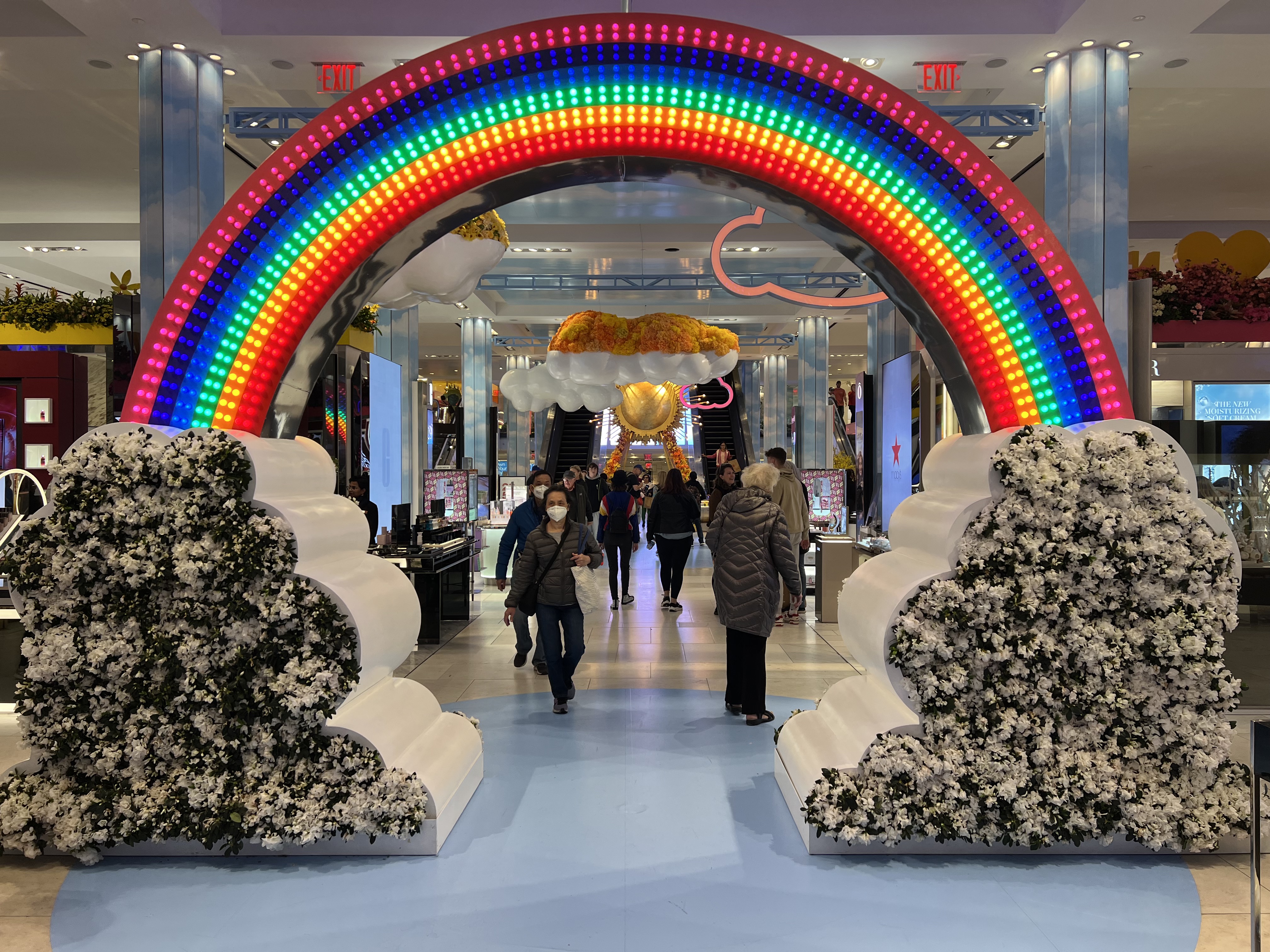Alicia Esposito shares the top 2024 retail trends and implications for tech
Alicia Esposito is the VP of Content for Retail TouchPoints. In her role, she strives to deeply understand the preferences of consumers to guide retail executives in their quest for success.
Alicia’s recent work includes interviewing top executives from renowned retail and tech companies, analyzing key trends in social commerce, web3, and next-gen store experiences. These efforts underline her commitment to providing retail leaders with the in-depth analysis and actionable insights they need to excel.
Our own Beth Warren met with Alicia to discuss trends informing retail technology and digital signage solutions today. Read on to hear insights regarding the evolution of retail over the past couple of decades, how brands are expanding from digital to physical, the growth of retail media networks, how brands are using AI to improve their marketing strategies, what loyalty looks like for today’s customer, and more.
 |
 |
| Alicia Esposito, VP Content, Retail TouchPoints |
Beth Warren, SVP Marketing and SME for Retail |
Beth: What have been the biggest innovations in retail that you've seen and reported on in the last decade?
Alicia: Social commerce - JC Penney was one of the first to add the shopping cart widget to their Facebook page, and that was huge at the time. The concept has evolved to now be about much more than the transaction itself. It's about the blending of inspiration and community engagement and using that as a facilitator and a connecting point to the transaction. We’re seeing social commerce evolve from a one-note kind of experience to a very fluid and immersive brand experience. It’s been interesting to see how both the advertising side and content side have really had to evolve to bring these two different phases or stages of the customer experience together. The transaction still matters, of course, but the journey a customer takes to the point of sale matters just as much.
Another is QR codes, though they have been around for a while. Back in 2012 or 2013, we were seeing brands putting QR codes on signage to get people to submit their emails to list building, sweepstakes, or giveaways. But they didn’t catch on as a trend across mediums. The pandemic changed that entirely. We saw QR use-cases really branch out to provide access to menus, services, information, healthcare… Now the QR code is recognized as a legitimate connecting point to rich media and rich content. Part of what makes QR codes so effective is the way they relieve the burden of having to do hardware or software applications at a physical location, allowing users to interact with content that’s native to their mobile device. More and more, people are using the convenience of mobile interaction as a barometer for how likely they are to interact with a service.
Beth: That last point you made about today’s consumer putting a priority on mobile connectivity brings me to another question about the trends in unified commerce. Can you tell us about other retail trends that are emerging out of today’s hyperconnectivity?
Alicia: Retail media entails much more today than simply advertising on a retailer’s website. When you look at the networks that are emerging today, you see a lot of advertising happening off site. There’s this idea now of even the physical store as being a media outlet. Brands are asking what the possible connecting points are between the physical space and all other digital channels. They’re trying to pinpoint how to make all that measurable and integrated, to ultimately create a cohesive storyline that’s able to articulate itself according to whatever context a customer is experiencing it in.
It turns out, measuring something like that is quite difficult. For any retailer – but for retail media specifically – the challenge in being able to pull this off effectively is figuring out what success looks like in this regard, asking what level or depth of metrics can be provided that will help brands make the best possible decisions. There are a lot of conversations going on now in the space about standardization and what that looks like in the retail media landscape. It’s a little hairy and very scientific.
Beth: Are you seeing brands focus more on shopper acquisition or retention today?
Alicia: For a while, especially among the digitally native brands, acquisition was the really big metric. But there’s been a shift, and I think it’s leveled out. We’re seeing more brands veer toward retention and loyalty-based strategies because cost per acquisition has gotten incredibly high, especially through providers like Google and Meta. Brands don’t want to be beholden to these huge companies anymore and are instead looking at things like retail media and even CCTV advertising. This helps them monetize and makes things a bit more measurable, allowing better insights into where they can place campaigns to get a first purchase or to get people into the store. So, we’re seeing these channels become a bit more sophisticated and not just with their ability to measure, but their targeting capabilities as well.
Beth: From a storytelling perspective, what are some ways you’re seeing retail media tying the threads of content, commerce, and community together in ways that encourage a sense of personalization for the consumer?
Alicia: There are some exciting non-tech, traditional elements re-emerging with brands thinking about their visual storytelling within stores. A lot of investments are being made by luxury brands – they’re investing in new formats and flagship environments. The goal is to blend the traditional retail selling of products with services and an experience of hospitality and entertainment. This appeals even to people who aren’t necessarily their core audience by providing a physical space that’s welcoming and engaging. And brands are discovering that this is an important part of the sales funnel, too.
Beth: That is exciting. For digital first brands who are wanting to expand into the physical space, what does that process look like?
Alicia: Those brands have flexibility and creativity that some of the traditional brands don’t, just due to their not having been tied to a real estate model. Glossier stands out as a good example of a digital first brand that, thanks to its creativity in engaging its user base during its digital phase, was able to effectively transition into the physical. They understand how today’s consumer wants to be part of, and capture, an experience. They interject an Instagrammable appeal into their campaigns. The brands that are finding ways to appeal to this growing desire among consumers to document “a good life” are the ones that are cementing themselves in consumer consciousness.

Beth: How are you seeing AI emerge in retail?
Alicia: It’s showing up in the backend of things, like workflows. It’s helping to jumpstart the ideation process for marketing and creative teams by automating routine and redundant elements of their work. And it can also help organize and analyze customer data effectively, too, which helps in distilling marketing strategies.
We’re also seeing a great use-case for AI within grocery stores. For example, Albertsons is using generative AI to optimize content and improve the customer experience through list-building apps based on recipes and integrating recommendations from those recipes. The technology can anticipate dietary restrictions or requirements and build out lists based on those user preferences, and that creates an experience of personalization and convenience simultaneously. It’s also advantageous for new brands or new product launches who are looking to find their target audience. It’s a great way to target customers without overwhelming them: people want minimalism, but they want it to be excellent.
Another advantage I see emerging with AI in retail is the ability to better understand loyalty customers and their behaviors through their mobile devices, which then allows brands to foster continuity with their in-store messaging and offerings while they’re shopping in-store. It supports the “couch to store” concept. So, AI can track and understand an individual’s behavior on mobile so when they enter the store, their journey continues. It can promote a product to try in-store, and then it can show you a recipe video with the product through in-store signage to really make the connection. It’s still in early days, but it seems a lot of retailers are doing this type of testing.
It's part of human nature to desire a little dash of novelty and a lot of predictability—which AI technology makes so much easier for brands to cater to.

Beth: Generative AI has a lot of potential for content creators, but like any new technology it has its limitations, especially when it comes to contextualizing content and/or engaging with humans on an emotional level. What do you recommend for brands who are looking to use AI and other technological tools to augment their content strategies?
Alicia: It comes down to really knowing your brand and your audience to begin with. Using a tool like AI when you lack knowledge about those basics will be a quick lesson in failure; it just can’t make up for lack of understanding. So, brands have to examine their aesthetic, their core messaging or value props, their customer expectations, and find how each of those things relates to the types of products they sell. They also need to find effective ways to test those trends and find what resonates.
But you know what really makes sense across the board? User generated content. That’s big, and it’s going to be big for the foreseeable future.
Beth: Can you expand on that? Why do you think user generated content is picking up so much steam today?
Alicia: Authenticity is more than just a buzzword for Gen Z. The whole notion of authenticity has taken on a lot of gravity for younger consumers. They’re tired of everything looking so polished and just-so; they crave things that are more real and raw. User generated content taps into that desire and allows for a systematic way of bringing real people into the retail experience. People trust people more than they trust brands. So, brands can and should be more generous with their audiences and let them take the reins a bit. They should listen to their customer and let the customer tell their story in their own words. Other people want that kind of sincere messaging–it’s what they’re looking for in the brands they support.
Beth: There’s an idea going around that people are less loyal than ever. Do you think that’s true?
Alicia: Not necessarily. I think people are more open-minded and choosier today, but I think that once they find something to be loyal to, they’re more devoted than patrons of the past were.
Brand loyalty is based on a lot more than efficiency of service and quality of product today. Now it’s also about legacy, community, and authenticity. People want to be part of the process; they want to feel like there’s a through-line between the brands they support and the people they care about.
I think we’re already seeing brands make that progression toward finding ways to make community wherever their brand is, while figuring out how to make those community moments commerce ready. The key is to really get into the psychology of how we interact with each other today.

Beth: Do any brands come to mind as leaders in community building?
Alicia: I like the way Liquid Death has figured out its niche so effectively. The guy who founded the company started out in the punk rock scene – which is a very tight knit community for many fans – and he noticed a lack of proper hydration at the musical festivals he attended. Musicians would be performing in the blazing heat, drinking booze or energy drinks or nothing at all, leading to some serious situations. So his idea was to create something hydrating and healthy that was also consistent with the culture and its vibe. Liquid Death is just that. And they’ve become the premier water provider for Live Nation Shows, all because their founder knew his audience so well and knew how to appeal to that community at an aesthetic level.
Beth: Last question for you. How can retailers ensure their employees feel empowered via the use of new technologies, and ultimately, encourage long term retention?
Alicia: People want their work to be meaningful and they want it to be safe. So, for retail businesses, the big topic is how to assess culture and ensure they’re doing everything they cannot just to empower employees at that moment but also create a path for further development and further connection to the business. Your employees are part of your brand. There should be consistency there. And in order to create that consistency, you have to invest in making your store a good place to work.
At one level that could entail updating employee facing areas and spaces in stores, creating a space where employees can actually recenter themselves during breaks. At the technology level, it could look like incorporating the kind of automation workflows and technology that will allow employees to focus on interacting with the customer. Facilitative sales technologies like digital signage, QR codes, or self-service kiosks allow employees to embrace a “choose your own journey” working style, to help them feel a bit more at ease so they can focus on connecting with customers, packing online orders, overseeing the fitting room, among many other things.
Beth: Alicia, thank you for sharing your time today. This was a phenomenal conversation about the blend of retail, technology and digital signage. Where can people follow you?
Alicia: Thank you for having me! You can follow my work at www.retailtouchpoints.com, or catch the podcast. Every week we sit down with top practitioners, analysts and innovators in retail to talk about what’s happening in the industry.
- Visit Retail TouchPoints and subscribe to their newsletter to get the latest and greatest content delivered to their inbox: https://retailtouchpoints.com/subscribe
- Connect with Alicia on LinkedIn or share story ideas with info@retailtouchpoints.com
Share this
You May Also Like
These Related Stories

Lessons from Fifth Avenue Retailers on the Realities of Digital Integration

Exploring the Generation Gap: How Gen Z's Inquisitiveness Shapes Retail Strategies


